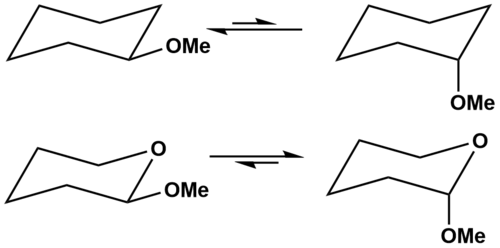Anomeric effect




Anomeric Effect
The anomeric effect is a chemical phenomenon first observed in the 1950s, which refers to the preference of certain substituents attached to an anomeric carbon in saccharides and other molecules to adopt an axial orientation rather than an equatorial one, despite the latter often being sterically more favorable. This effect is particularly significant in the chemistry of carbohydrates and has implications for the structure and reactivity of glycosides, cyclic sugars, and many other biomolecules.
Overview[edit]
The anomeric effect is observed in cyclic structures, particularly in pyranoses and furanoses, which are six-membered and five-membered ring sugars, respectively. The term "anomeric" refers to the carbon atom in these sugars that was the carbonyl carbon before cyclization; this carbon is known as the anomeric carbon. The effect influences the conformation of the sugar molecule, affecting its physical and chemical properties.
Mechanism[edit]
The traditional explanation for the anomeric effect involves the interaction between the lone pair electrons of the oxygen atom (or other heteroatoms) attached to the anomeric carbon and the antibonding orbital of the adjacent bond (usually C-O or C-X bond, where X is a halogen). This interaction leads to stabilization of the axial conformation through a phenomenon known as hyperconjugation.
Recent studies suggest that the effect can also be attributed to the dipole moment created by the orientation of the substituents, which stabilizes the molecule further. The combination of these electronic effects results in the anomeric carbon preferring to adopt a specific configuration, which has significant implications for the structure and reactivity of the molecule.
Implications[edit]
The anomeric effect has profound implications in the field of biochemistry and organic chemistry. It influences the structure of glycosidic bonds in polysaccharides and the stability of glycosides. This effect is crucial for understanding the behavior of carbohydrates in aqueous solutions and their interactions with enzymes and other biomolecules. It also plays a role in the synthesis of carbohydrate-based drugs and the design of molecular sensors.
Examples[edit]
One of the most common examples of the anomeric effect is observed in the cyclic form of glucose, where the hydroxymethyl group at the anomeric carbon prefers the axial orientation in the alpha-anomer, despite the steric repulsion that would favor an equatorial position. This preference is a direct consequence of the anomeric effect and has significant implications for the properties and reactivity of glucose and other sugars.
Conclusion[edit]
The anomeric effect is a fundamental concept in carbohydrate chemistry, influencing the structure, reactivity, and biological function of sugars and glycosides. Understanding this effect is essential for the fields of biochemistry, organic chemistry, and pharmaceutical science, as it underpins the behavior of one of the most important classes of biomolecules in nature.
Ad. Transform your life with W8MD's Budget GLP-1 injections from $75


W8MD offers a medical weight loss program to lose weight in Philadelphia. Our physician-supervised medical weight loss provides:
- Weight loss injections in NYC (generic and brand names):
- Zepbound / Mounjaro, Wegovy / Ozempic, Saxenda
- Most insurances accepted or discounted self-pay rates. We will obtain insurance prior authorizations if needed.
- Generic GLP1 weight loss injections from $75 for the starting dose.
- Also offer prescription weight loss medications including Phentermine, Qsymia, Diethylpropion, Contrave etc.
NYC weight loss doctor appointmentsNYC weight loss doctor appointments
Start your NYC weight loss journey today at our NYC medical weight loss and Philadelphia medical weight loss clinics.
- Call 718-946-5500 to lose weight in NYC or for medical weight loss in Philadelphia 215-676-2334.
- Tags:NYC medical weight loss, Philadelphia lose weight Zepbound NYC, Budget GLP1 weight loss injections, Wegovy Philadelphia, Wegovy NYC, Philadelphia medical weight loss, Brookly weight loss and Wegovy NYC
|
WikiMD's Wellness Encyclopedia |
| Let Food Be Thy Medicine Medicine Thy Food - Hippocrates |
Medical Disclaimer: WikiMD is not a substitute for professional medical advice. The information on WikiMD is provided as an information resource only, may be incorrect, outdated or misleading, and is not to be used or relied on for any diagnostic or treatment purposes. Please consult your health care provider before making any healthcare decisions or for guidance about a specific medical condition. WikiMD expressly disclaims responsibility, and shall have no liability, for any damages, loss, injury, or liability whatsoever suffered as a result of your reliance on the information contained in this site. By visiting this site you agree to the foregoing terms and conditions, which may from time to time be changed or supplemented by WikiMD. If you do not agree to the foregoing terms and conditions, you should not enter or use this site. See full disclaimer.
Credits:Most images are courtesy of Wikimedia commons, and templates, categories Wikipedia, licensed under CC BY SA or similar.
Translate this page: - East Asian
中文,
日本,
한국어,
South Asian
हिन्दी,
தமிழ்,
తెలుగు,
Urdu,
ಕನ್ನಡ,
Southeast Asian
Indonesian,
Vietnamese,
Thai,
မြန်မာဘာသာ,
বাংলা
European
español,
Deutsch,
français,
Greek,
português do Brasil,
polski,
română,
русский,
Nederlands,
norsk,
svenska,
suomi,
Italian
Middle Eastern & African
عربى,
Turkish,
Persian,
Hebrew,
Afrikaans,
isiZulu,
Kiswahili,
Other
Bulgarian,
Hungarian,
Czech,
Swedish,
മലയാളം,
मराठी,
ਪੰਜਾਬੀ,
ગુજરાતી,
Portuguese,
Ukrainian
